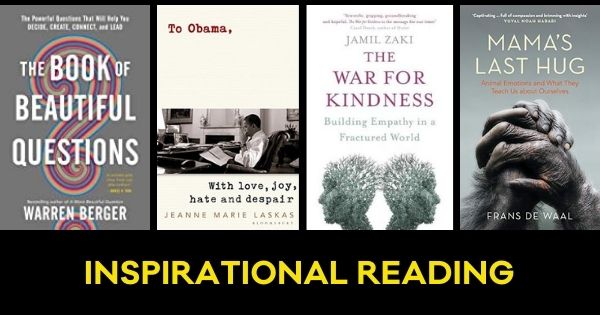In writing my latest book, Customer Empathy: A radical intervention in customer experience management and design, there were four books in particular that helped me shape the narrative and inspired my thinking.
So that we’re all on the same page, so to speak, empathy is understanding another person’s point of view, feeling what the other person is experiencing and considering this in your decisions. Empathy can be explained as the ability to feel, share and match another’s emotions.
And so, to the books.
The War for Kindness: Building Empathy in a Fractured World by Jamil Zak
This book demonstrates that empathy is a skill that when practised, gets stronger and by choosing empathy we grow more empathic over time. The author has studied the psychology of empathy and offers a very different perspective of how empathy works.
Inspired Quote
“The victims were statistics, and strangers – two big reasons not to empathize.” Psychologist Dan Batson “… knew that people naturally care about single individuals and their stories. Could he leverage that to get them to empathize with a whole group?”
Applied in Teams
We must ask ourselves, are we too readily reducing our customers to just a number, a statistic – or in customer experience measurement, a score. Scores create a customer visibility gap. This visibility gap is a barrier to deep, meaningful connection and understanding with customers.
Customer Empathy in Action
- To understand customers we need to develop connection by seeing and feeling their experiences, and hearing them.
- Customer storytelling is a powerful driver of empathy; helping employee teams step into their customers’ lives using customer journey maps and CX emotion graphs.
- Demonstrate the customers’ perspective through visual language; customer verbatim comments, video and sound bites.
- Use the emotion graph to show emotion highs and lows; from customer feelings of excitement to feelings of frustration.
Mama’s Last Hug by Frans de Waal
This book is about animal emotions and what we can learn about ourselves as humans. Just as humans have the capacity to feel love, happiness, hate, fear, shame and empathy, so too do animals. Through exploring animal facial expressions, politics and consciousness, the author explores the significance of emotion in experiences.
Inspired Quote
“Our empathic connection with others is like an under-the-table handshake between bodies, perceived as a “vibe” which may be positive and inspiring, or toxic, sapping our energy.”
Applied in Our Day-to-Day
Empathy enables us to connect human to human; it feeds our interest in each other – as much as we try, we can’t help but be affected by another’s emotional state.
Customer Empathy in Action
- Enable employee teams to feel connected to customers and their experiences.
- Switch on listening to customer conversations to hear the customer’s point-of-view.
- Empower employees to use their customers’ perspectives in their problem solving and decision making.
To Obama: With Love, Joy, Anger, and Hope by Jeanne Marie Laskas
This book is about Barack Obama’s presidency in the White House. During this time he would receive on average, 10,000 letters every day. When Obama incorporated the ritual of listening to ‘the people’s voice’ into his demanding daily schedule, his actions sent a clear message to the White House – the people we serve, the American public – their lives matter. To understand their lives and their needs, we need to listen to their stories.
Inspired Quote
Obama says of his dedication to listening to understand, “… this form of story sharing and empathy and listening … creates the conditions around which we can then have a meaningful conversation …”
Applied in Organisational Culture
Actively listening to customers demonstrates what we value. Obama didn’t mandate his daily listening practice across the White House. This wasn’t a forced regime. Instead, he led with his actions and demonstrated empathy through his everyday behaviours. Through his empathetic leadership style constituency listening became a priority; part of the White House’s culture.
Customer Empathy in Action
- Start having first-hand customer conversations to understand their experiences from their perspective.
- Get your teams out in the field (out from behind their desks) listening to customer stories in the call centre, sales presentations etc.
- Empower teams to listen with empathy by creating nudges and rituals that demonstrate the businesses commitment.
The Book of Beautiful Questions by Warren Berge
Asking the right questions at the right time is a powerful empathy tool. The author makes the point that kids ask endless ‘why’ and ‘what if’ questions – however, they gradually ask fewer questions as they progress through school. By the time we start our careers many of us no longer ask the fundamental questions to deeply understand the context, problem or situation.
Inspired Quote
“If I had an hour to solve a problem and my life depended on the solution, I would spend the first 55 minutes determining the proper question to ask, for once I know the proper question, I could solve the problem in less than five minutes.”
Applied in CX Solutions
I couldn’t agree more! Most of the time, we get fixated on the solution. We fall in love with our ideas without exploring through asking questions the other ways of seeing the problem – then we ask questions to confirm our decision.
Customer Empathy in Action
- The challenge is, given what we know, how do we take a fresh perspective? To do this you’ll need to adopt a learner mindset.
- Get ‘customer curious’ about customers’ needs and expectations and importantly, their emotions associated with their experiences.
- Ask the right questions at the right time … and actively listen to your customers view points.
Over many years I’ve seen how, when we help teams to empathise, this enables them to see the customer’s world differently. Empathy impacts how employees think, problem solve and make decisions to make a difference in customers’ lives.

